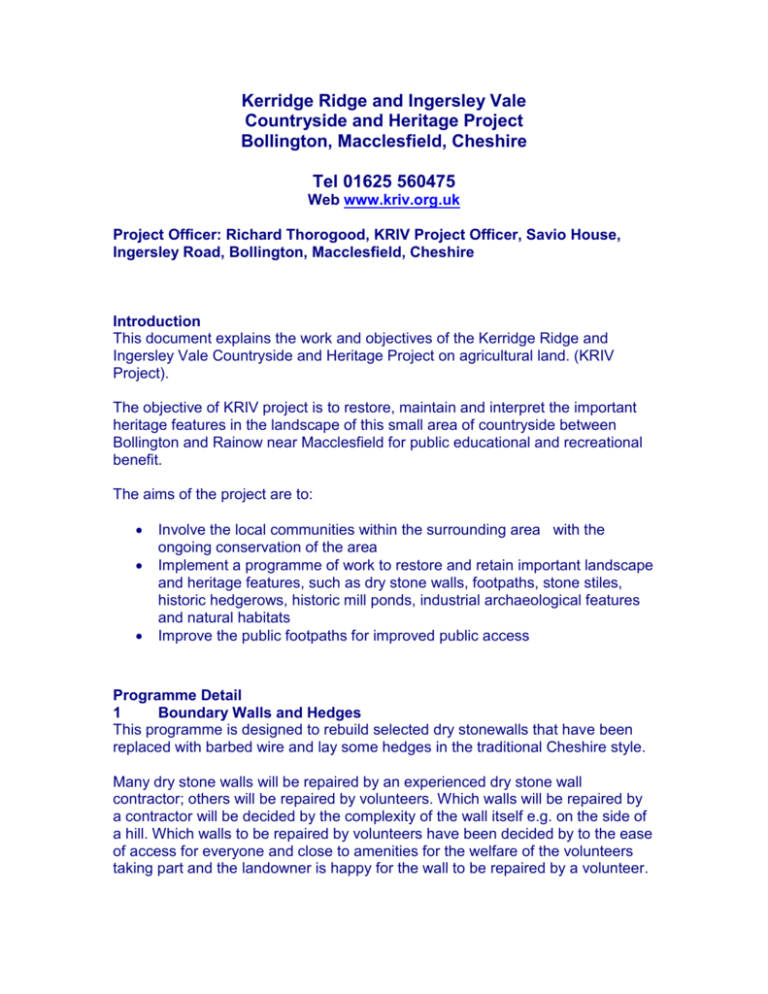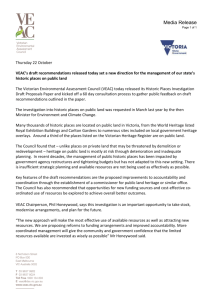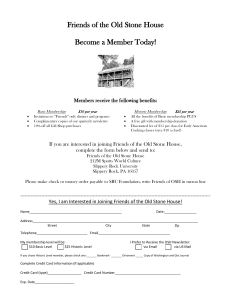File - Kerridge Ridge & Ingersley Vale Project
advertisement

Kerridge Ridge and Ingersley Vale Countryside and Heritage Project Bollington, Macclesfield, Cheshire Tel 01625 560475 Web www.kriv.org.uk Project Officer: Richard Thorogood, KRIV Project Officer, Savio House, Ingersley Road, Bollington, Macclesfield, Cheshire Introduction This document explains the work and objectives of the Kerridge Ridge and Ingersley Vale Countryside and Heritage Project on agricultural land. (KRIV Project). The objective of KRIV project is to restore, maintain and interpret the important heritage features in the landscape of this small area of countryside between Bollington and Rainow near Macclesfield for public educational and recreational benefit. The aims of the project are to: Involve the local communities within the surrounding area with the ongoing conservation of the area Implement a programme of work to restore and retain important landscape and heritage features, such as dry stone walls, footpaths, stone stiles, historic hedgerows, historic mill ponds, industrial archaeological features and natural habitats Improve the public footpaths for improved public access Programme Detail 1 Boundary Walls and Hedges This programme is designed to rebuild selected dry stonewalls that have been replaced with barbed wire and lay some hedges in the traditional Cheshire style. Many dry stone walls will be repaired by an experienced dry stone wall contractor; others will be repaired by volunteers. Which walls will be repaired by a contractor will be decided by the complexity of the wall itself e.g. on the side of a hill. Which walls to be repaired by volunteers have been decided by to the ease of access for everyone and close to amenities for the welfare of the volunteers taking part and the landowner is happy for the wall to be repaired by a volunteer. The hedges identified will be laid by experienced hedge layers and volunteers. The experienced hedge layers will be able to demonstrate to the volunteers this historic rural skill. Contractors will be invited to quote for the different projects. The amount quoted for the job will be considered against the level of craftsmanship and experience that the individual has. Not all jobs will be given to the same contractor and not necessarily to the lowest quote. [Comment: under EU law the locality of the contractor may not be used as a criterion for selection]. 2 Access This programme aims to assist Cheshire County Council with improvements to the public rights of way network. Old wooden stiles will be replaced with kissing gates to improve access for those unable to climb over a stile. The surface of selected popular footpaths will be improved in areas that are water logged in winter. The paths selected are at the request of the local Parish Council footpath committees and/or popular routes used by walkers. 3 Historic Sites This programme aims to help repair and retain identified historic heritage features in the landscape. This programme forms the basis of the concept of the project as it is these features that the local community would like to see retained before they are lost forever. The features identified have a significant local interest to the industrial past of the cotton and silk mills in the area and the local stone quarries. The features have no economic value to the landowner which is why they have been left to deteriorate over the decades. The grant from the heritage lottery fund will enable these features to be saved. 4 Water Courses This programme is very small in comparison to the others. There are two stone footbridges in the project area that need a little expertise to help retain them for a future generation. Again they have been selected for their value as a historic feature and if allowed to fall further in disrepair they will be replaced by modern wooden footbridges that will not blend in with the surrounding landscape. The bridges do not have an economic value to the landowner. The funding for the project is handled through Groundwork Cheshire who employs the Project Officer on behalf of the Steering Group and manages the project finances. The total project budget over 4 years is £1.1 million including all administrative costs and work on non-agricultural land. The total cost of the physical work that will take place on agricultural land is £145 500. This can be broken down further on an annual basis by financial year: Year 1 has a budget of £24000 for 06/07 Year 2 has a budget of £72500 for 07/08 Year 3 has a budget of £42000 for 08/09 Year 4 has a budget of £7000 for 09/10 State aid Improvements to property paid for under this scheme may involve state aid. The payment of state aid is restricted by European law. Aid to agricultural businesses under this scheme will be paid in line with EC Regulation 1/2004. Landowners who are involved in non agricultural businesses will be covered by the National Heritage Memorial fund (NN 11/2002) scheme which has been specifically approved by the European Commission. How have the specific projects been identified? The Project partnership has employed consultants to prepare plans that identify the historical, ecological and landscape significance of the area and a fully costed programme of work to restore specific features have been prepared. The early studies in 1998 and 1999 were paid for by Groundwork Macclesfield and Vale Royal. Further comprehensive studies in the historical nature of the landscape, ecological appraisal and landscape survey were paid for by a grant from the Countryside Agency Local Heritage Initiative fund. The reports formed the basis for determining the direction of the project. They are available in the local library. To support an application to the Heritage Lottery Fund a landscape management plan was required. This was paid for from a Heritage Lottery Fund project preparation grant. The consultants were selected by a tender process under the guidance of the financial regulations from Groundwork Cheshire. Three companies were invited to tender. Two were selected for interview and a decision made by the project’s steering group. Groundwork Cheshire is the accountable, body for the project. The selection of contractors will follow their financial regulations for the Trust. A copy of these regulations is attached. Only small and medium-sized enterprises are eligible for the scheme. SMEs are defined in Commission Recommendation 2003/361/EC, being enterprises which: - have fewer than 250 employees; - have either an annual turnover not exceeding €50 million or an annual balance sheet not exceeding €43 million; and - conform to specified criteria of independence (in general, not more than 25% of an SME can be owned by other companies) Aid to agricultural businesses under this scheme will be provided in accordance with Article 5.2 of EC Regulation 1/2004 which governs the granting conservation of traditional landscapes and buildings. All the 35 landowners (a mix of agricultural and non-agricultural landowners) in the area have been consulted and permission requested for the Project to carry out work on their land. Only projects that have been agreed by the landowners or farmers are being implemented. Not all landowners have agreed to take part in the project. Some have indicated that they wish to view the progress of the project before allowing any work to take place on their land. Each landowner who would like to take part in the project will be asked to sign a legal agreement that will confirm the details of the work to be carried out and confirm permission and any specific details if required e.g. access on to the land. The projects have been chosen during the planning stage of the project in order to meet the requirements of the funding bodies. The appointed consultants for the project contacted all the landowners and where possible met them to discuss any proposed ideas to include in the project. Remembering that the aim of the project is to retain and restore industrial heritage features in the local landscape, this helped both parties identify projects that may be included in the overall scheme. During public consultation events the community had an opportunity to put forward ideas about the heritage features that have been identified in the landscape. Those that are of particular interest to the local community were included in the funding application if the landowner agreed. If the landowner is in agreement that the feature should be included in the project, discussions take place how it is best to repair the feature. Work to be carried out to conserve traditional landscapes. The measures being carried out that are eligible for support are as follows: The restoration of historic stone walls important as landscape features The restoration of historic hedgerows important as landscape features The repair of stone stiles The repair of stone footpaths and steps Woodland management and scrub clearance Consolidation of an historic ruined mill Restoration of mill ponds for ecological and aesthetic enhancement This work will not lead to an increase in production capacity. The gross aid intensity is 100% of the real costs incurred as regards investments or capital works intended for the conservation of non-productive heritage features located on agricultural holdings such as archeological or historical features. This is in accordance with Article 5.2 of EC Regulation 1/2004. Who will carry out the work? The work will be carried out in two main ways: 1 Through competitive tendering by contractors 2 By volunteers under the supervision of the British Trust for Conservation Volunteers. How will the restored features be maintained? The landowners upon whose land any work is carried out are signing an agreement that they will maintain the specific feature for a minimum of 10 years with the help of Groundwork Cheshire. If the landowner is unable to maintain the feature, Groundwork Cheshire reserves the right to repair the feature using the trained volunteer network that will be available from the local community or appoint a skilled contractor if required. The County Council is responsible for the Public Rights of Way and will continue to maintain them in partnership with the landowner. The features that have been restored during the 4-year implementation stage of the project will be inspected 1 year, 5 years and 10 years after completion of the project. It is the responsibility of the accountable body – Groundwork Cheshire to make sure that these features are kept in a good condition and remain accessible to the public (all features repaired are on or near a public footpath). It is hoped that local volunteers will help the landowners carry out any minor maintenance that may be required over this time period. If the feature is damaged severely, a contractor may be required to carry out the maintenance of the feature. A maintenance budget is included in the project to allow the cost of employing a contractor to repair any damage to the feature. Record Keeping All financial records and project records are being kept by Groundwork Cheshire via the Project Officer. Duration of the scheme The scheme will start on December 2006. The scheme will close on 30 June 2010 All payments will be made by 31 March 2010








